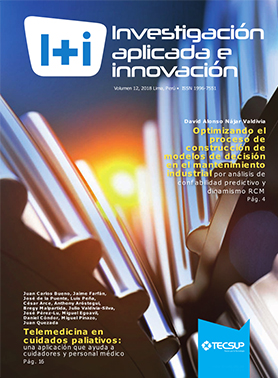Alert and Capture of Rodents Electronic System for the Agro-Industrial Sector
DOI:
https://doi.org/10.71701/34005631Keywords:
Sensors, pests, industry, electronic system, rodents, WiFi, softwareAbstract
In Peru, rodent control requires a lot of time and effort from the pest controller. An agro-industrial company puts in place between 50 to 200 devices, which are checked periodically. Sometimes rodents are found in a state of putrefaction with a high risk of contamination. The objective is to develop a permanent rat extermination method (24 hours / 7 days) in substitution of the «traditional» method. For this reason, a smart control system was developed, which sends alerts to the presence or capture of a rodent in the devices, either by means of a text message or email message, allowing a quick intervention; it counts on also with a software package that records all the captures and events in the devices. The project was developed from March to December 2017. In the laboratory phase, the prototypes 1, 2 and 3 were designed and assembled; later a prototype 4, imported, was included for comparison purposes with the previous ones. The tests were carried out at Control SAC., in La Victoria, Lima. Prototypes with the highest efficiency in sending communications were prototype 1 and 4 with 100% and 95.76% efficiency, respectively. The selected prototypes went to the field phase, which was carried out in three companies of the agro-industrial sector, located in Callao and Lurin. The average efficiency of prototypes 1 and 4 were 88.31% and 90.53%, respectively. The economic analysis showed us that prototype 1 turned out to be 24.3% cheaper than prototype 4. Both prototypes showed greater commercial viability for the local market, taking into account that the first works with a WiFi network, while the second with text messaging (alternation in the commercial portfolio of the company). During the developing of the project, it was achieved a continuous monitoring for the control of rodents (24 hours / 7 days).
Downloads
References
Andrea, V. (2008). Desarrollo de software para la simulación espacio-temporal de la dinámica poblacional de roedores transmisores de fiebre hemorrágica. Recuperado de https://bit.ly/2OfsKGU
Anticimex (2016). Anticimex Smart: Control digital de plagas 24/7. España: Anticimex. Recuperado de https://www.anticimex.com/es-ES/smart/
Atmel Corporation (2016). ATmega328/P. Datasheet complete. Recuperado de https://bit.ly/2FsXRXp
Chaves, P. (2008). Sensores analógicos utilizados en la automatización industrial. Universidad de Costa Rica.
Christopher T., et. al. (2015, 7 de julio) Wireless notification systems and methods for electronic rodent traps. Recuperado de https://www.google.com/patents/US20160192635.
Decreto Supremo N.° 022–2001-SA. Reglamento sanitario para las actividades de saneamiento ambiental en viviendas y establecimientos comerciales industriales y de servicios. Diario Oficial El Peruano. Lima. Perú, 16 de julio de 2001.
Espressif Systems IOT Team. (2015). ESP8266EX Datasheet. Versión 4.3. Recuperado de https://cdnshop.adafruit.com/product-files/2471/0A-ESP8266__Datasheet__EN_v4.3.pdf
FAO (Organización de las Naciones Unidas para la alimentación y agricultura). (2016). Control de roedores (un resumen). Depósito de documentos de la FAO. Recuperado de http://www.fao.org/docrep/x5052s/ x5052S04.htm
Fraden, J. (2004). Handbook of Modern Sensors (Physics, Designs and Applications) (3a ed.). San Diego: Springer.
Fundación CTIC. (2016). ¿Qué es el internet de las cosas? Recuperado de http://www.fundacionctic.org/sat/articuloque-es-el-internet-de-las-cosas
Kramer. M. et. al. (2013, 26 de diciembre). Wireless Mousetrap and System. Recuperado de https://www.google.com/patents/US20130342344
Pallas, R. (2004). Sensores y acondicionadores de señal. (3a ed.). Barcelona: Marcombo.
Sheahan M., y Andrews, P. (2008). Rat Trap [inventors inbox]. Engineering & Technology, 3(14), 34-35. Recuperado de https://bit.ly/2yunoNt
Ramírez, F. (2015). Área de consolidación gestión de la producción de agroalimentos. Programa de manejo integrado de plagas para la industria desactivadora de soja Recuperado de https://bit.ly/2PpYQwj
Rentokil (2016). Radar. Una solución innovadora, discreta y humanitaria para la eliminación de ratones. Recuperado de https://bit.ly/2RDrpI5
Resolución Ministerial N.° 449-2001: Norma para la desinsectación, desratización, desinfección, limpieza
y desinfección de reservorios de agua, limpieza de ambientes y de tanques sépticos. Diario Oficial El Peruano. Lima. Perú, 26 de julio de 2001.
Wisecon (2015). Wisebox. Effective control of rats and mice on the surface. Dinamarca. Wisecon. Recuperado de http://www.wisecon.dk/en/produktkategori/wisebox-en/
SIMCom (2013). SIM 800L Hardware Design V1.00. Recuperado de http://wiki.seeedstudio.com/images/4/46/SIM800L_Hardware_Design_V1.00.pdf
SIMCom (2013). SIM 900 Hardware Design V2.05. Recuperado de http://simcom.ee/documents/SIM900/SIM900_Hardware%20Design_V2.05.pdf
Downloads
Published
Issue
Section
License

This work is licensed under a Creative Commons Attribution-NonCommercial 4.0 International License.


